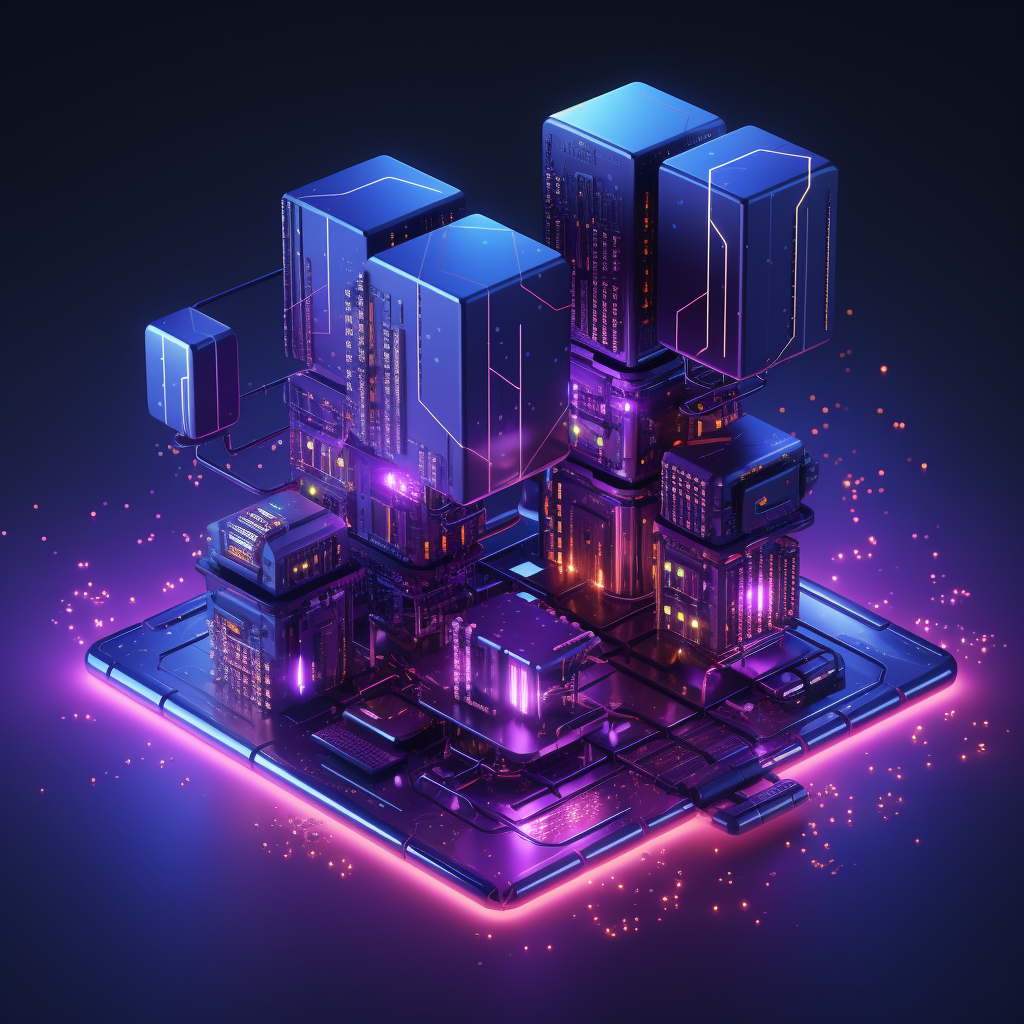Artificial Intelligence (AI) and Large Language Models (LLMs) are pivotal forces in today’s data-driven economy, automating tasks and extracting valuable insights from extensive data sets. The rise of advanced models like GPT-4, Llama-2, and Falcon 180B showcase significant growth in capabilities, with applications spanning healthcare, finance, and technology.
Expected to contribute $15.7 trillion to the global economy by 2030, this technological surge has driven the need for secure, customized AI solutions for enterprises. AMAX specializes in developing on-premises AI solutions that fit seamlessly into your organization’s infrastructure. Our focus on superior data security and control is particularly vital for managing sensitive or proprietary information.

How can LLMs generate value for your organization?
LLMs offer substantial advantages to organizations across various work-related tasks and domains enhancing everything from customer service to data analysis.
Cost Reduction:
- Automating Customer Support: LLMs can be used in chatbots or virtual assistants to handle a significant portion of customer queries, reducing the need for human intervention and thereby saving costs.
- Content Creation: Organizations can use LLMs to generate content for blogs, reports, and more, saving time and money. For instance, generating first drafts or creating SEO-oriented articles can be expedited with LLM assistance.
Enhanced Productivity:
- Code Assistance: Developers can use LLMs to assist in writing code, debugging, or even generating code snippets, thereby speeding up project timelines.
- Research & Data Analysis: LLMs can help researchers quickly sift through vast amounts of data, summarizing findings or even suggesting potential hypotheses, which can be a catalyst for innovative breakthroughs.
Improved Decision Making:
- Market Analysis & Insights: LLMs can analyze vast amounts of textual data from sources like social media, news, and forums to provide insights about market trends, customer sentiments, and emerging topics, enabling data-driven strategies.
- Executive Summaries: LLMs can help executives by summarizing lengthy reports, research papers, or news articles, enabling them to quickly grasp key points and make informed decisions.
Customer Engagement:
- Personalization: LLMs can help in personalizing content for users based on their preferences, increasing user engagement and satisfaction, which in turn can boost customer loyalty.
- Interactive Campaigns: Marketing teams can utilize LLMs to create interactive campaigns or quizzes that engage customers in unique ways, enhancing brand experience.

Learning & Development:
- Training: LLMs can be used to create personalized learning paths for employees, answering queries and providing resources on-demand, thus fostering a continuous learning environment.
- Language Translation: For global organizations, LLMs can assist in translating content, making it easier to disseminate knowledge across geographies, fostering global collaboration.
Risk Management:
- Document Review: LLMs can assist in reviewing contracts or legal documents, highlighting potential areas of concern, aiding in compliance and risk mitigation.
- Cybersecurity: While this is more specialized, LLMs can be trained to recognize phishing attempts in textual content or to assist in generating cybersecurity awareness content, bolstering organizational cybersecurity posture.
Multilingual Support:
- LLMs trained on multiple languages can assist organizations in providing multilingual support, translating content, and ensuring global reach.
LLMs including text generation models such as ChatGPT, and art generation models such as Midjourney, have emerged as two domains that captivate both industry professionals and the general public. While LLMs are revolutionizing natural language processing, generative art is blending the boundaries between technology and creativity. However, the deployment and operation of these AI technologies come with specific requirements that are not simple to implement.
Hardware Requirements:
- Processing Power: LLMs, especially during their training phase, require immense computational resources. Multiple GPUs or even GPU clusters are often employed to expedite the training process. The parallel processing capabilities of GPUs make them indispensable for handling the matrix operations inherent in neural networks.
- Memory: The sheer size of LLMs demands substantial RAM and GPU memory. For instance, models with billions of parameters necessitate high-capacity memory solutions to ensure smooth operations, especially during inference where real-time responses are expected.
- Storage: Training LLMs involves processing vast datasets. NVMe SSDs or even more advanced storage solutions are crucial to ensure rapid data retrieval and storage, minimizing I/O bottlenecks during training.
Operational Requirements:
- Latency: For applications that demand real-time interactions, such as customer support chatbots, minimizing latency is crucial. This requires not just powerful hardware but also optimized software and model architectures.
- Scalability: As LLMs continue to evolve, newer versions often come with increased complexity. Infrastructure should be inherently scalable, allowing for the addition of more GPUs or memory without necessitating a complete overhaul.
AI and Hardware Synergy
AI is intricately linked with the silicon that powers it. This relationship between AI and hardware is a fundamental aspect that influences the pace and extent of advancements in AI. As AI applications extend from data centers to edge computing, the need for hardware capable of meeting AI’s demanding computational and memory requirements becomes apparent.
Parallelism in AI: Deep learning, a subset of AI, often involves neural networks with millions, if not billions, of parameters. Training such networks necessitates the concurrent processing of vast amounts of data. Traditional CPUs, designed for sequential processing, are ill-equipped for this task. This is where GPUs, with their parallel processing capabilities, come into play and support these AI models. They can handle thousands of threads simultaneously, making them indispensable and irreplaceable for AI workloads.
Memory and Bandwidth: AI models, especially those used in real-time applications like autonomous vehicles or financial trading, require rapid data access. Any lag or bottleneck in data retrieval can be detrimental. AMAX’s solutions prioritize high memory bandwidth, ensuring that data is always available for processing without critical delays that could make the entire operation useless. By alleviating data retrieval bottlenecks, a conducive environment for real-time decision making is now possible, which is fundamental for achieving superior performance in applications like operating a motor vehicle or being used in a real-time manufacturing workflow.
Customized Hardware Solutions: Adapting hardware to the specific needs of AI applications is a vital. At AMAX, we specialize in designing solutions that align with the unique demands of companies implementing AI or high GPU tasks. Regardless of whether you are making specialized GPU configurations or developing storage solutions, the objective remains clear – to provide a hardware ecosystem that works well with the AI algorithms it hosts. This relationship between hardware and software not only improves performance but also enhances reliability and scalability in modern AI applications. Through a combination of experience driven engineering and a deep understanding of AI operations, we are able to deliver working, support driven solutions that unlock new capabilities for businesses.

Generative Art
Generative Art is the fusion of algorithmic processes and artistic creativity. Using complex algorithms, especially neural networks like Generative Adversarial Networks, as well as mountains of training data, unique and often intricately detailed pieces of art are generated on the fly. These can range from digital paintings to music and even interactive installations.
Operational Considerations:
- Iteration Speed: Artists often tweak algorithms, adjust parameters, or change input data to achieve the desired output. The infrastructure should support these rapid iterations, allowing artists to see the results of their tweaks in real-time or near-real-time.
- Diversity and Uniqueness: One of the hallmarks of art is its uniqueness. The hardware and software infrastructure should be robust and versatile enough to support a wide array of algorithms and techniques, ensuring that the generated art remains distinctive.
Both LLMs and Generative Art, while representing different facets of AI, underscore the technology’s transformative potential. However, realizing this potential demands an in-depth understanding of their operational intricacies. With its AI-optimized solutions, AMAX is uniquely positioned to cater to these requirements, ensuring optimal performance and seamless integration.

AMAX’s AI-Optimized Server Architecture
Scalability: In the dynamic world of AI, where models and requirements evolve rapidly, scalability is not just an advantage—it’s a necessity. AMAX’s server solutions are designed with this principle at their core. Whether a business is taking its first steps into AI or scaling up its operations, AMAX’s servers can adapt, ensuring that growth never encounters hardware limitations.
Power, Efficiency, and Sustainability: The computational intensity of AI operations often translates to high power consumption. Aware of the environmental implications and operational costs, AMAX has championed the cause of energy-efficient server designs. By optimizing power usage, AMAX’s servers not only reduce operational costs but also contribute to a greener planet.
Tailored Solutions: AI is not a monolithic entity. Different applications, from natural language processing to computer vision, have distinct requirements. AMAX’s approach recognizes this diversity. By offering customizable server configurations, AMAX ensures that businesses have hardware that’s tailored to their specific AI needs, eliminating overprovisioning and resource wastage.
Collaboration with Industry Titans – NVIDIA’s DGX Systems
In the realm of AI hardware, NVIDIA’s DGX systems are often hailed as the gold standard. These systems, designed from the ground up for AI, offer unparalleled performance. AMAX, in its commitment to delivering the best, has forged a collaboration with NVIDIA. This partnership ensures that AMAX’s clientele has access to the pinnacle of AI hardware, complemented by AMAX’s expertise and support.
The architecture of a server, much like the foundation of a building, determines its strength, efficiency, and adaptability. As AI continues to evolve, transforming industries worldwide, traditional server architectures are being re-evaluated. The unique demands of AI require a fresh approach, one that AMAX has been pioneering.
Traditional Server Architecture
Historically, server architectures have been designed with a broad spectrum of tasks in mind. These servers, often CPU-centric, are optimized for sequential processing tasks. They are equipped with storage, memory, and processing units that handle a variety of general-purpose applications, from web hosting to database management. While versatile, these architectures often lack the specialized components required for intensive parallel processing, a hallmark of AI workloads.
AI-Optimized Server Architecture
Servers optimized for AI are often GPU-centric, recognizing the GPU’s unique ability in handling parallel operations—a necessity for deep learning models. Beyond just the GPU, AI-optimized servers incorporate high-bandwidth memory, rapid storage solutions like NVMe SSDs, and interconnects that facilitate swift data transfer between components. Every facet of this architecture is tailored to minimize bottlenecks and maximize throughput, ensuring that AI models are trained and deployed efficiently.
Scaling Single Servers to Data Centers
One of the standout features of AMAX’s AI-optimized server solutions is scalability. In the early stages of AI adoption, a single server might have sufficed. However, as businesses expand their AI endeavors, the computational demands grow exponentially. AMAX’s solutions are designed to scale seamlessly. Whether it’s adding more GPUs to a server, incorporating additional servers, or even expanding to a full-fledged data center with interconnected servers, AMAX ensures that growth is unhindered. This scalability ensures that businesses can start small and grow without the need for a complete architectural overhaul.
Power Consumption and Cooling Considerations
AI operations, with their computational intensity, can be power-hungry. This not only has cost implications but also presents challenges in terms of heat dissipation. An overheated server can lead to reduced component lifespan and even system failures. AMAX’s AI-optimized servers are designed with these challenges in mind.
Our severs are engineered for power efficiency, ensuring that every watt is thoughtfully used. Advanced cooling solutions, ranging from direct-to-chip liquid cooling to immersion cooling are also available for increased thermal management. These cooling solutions ensure that the servers operate within optimal temperature ranges, preserving component health and ensuring uninterrupted AI operations.

Revolutionize your Enterprise with AMAX
Choosing AMAX for your AI needs means getting strong, custom solutions that match your business goals. With AMAX, you’re getting more than just great hardware; you’re teaming up with a group of dedicated experts eager to help achieve your AI dreams. Our team knows how to build special IT solutions ensuring your AI applications run smoothly, with a support team ready for any challenges.
Your desire for AI innovation needs a solid base of reliable and high-performance tools. With AMAX helping you, you’re not just keeping up with tech changes; you’re stepping into a new era of innovation, keeping your business ahead in the game. Our approach looks at the big picture, understanding your AI goals well, ensuring your tools and goals are in sync. Join hands with AMAX, and you’ll have a partner ready to walk the complex path of AI innovation with you, turning hurdles into stepping stones towards AI-powered business success.

FAQs (Frequently Asked Questions)
What is Generative AI?
Generative AI is an advancement in artificial intelligence that empowers systems to create content. It’s the force behind the creation of realistic images, textual content, and other types of media, mirroring human-like creativity.
Why is Generative AI so popular?
The ability of Generative AI to automate content generation is revolutionizing industries, aiding in design, marketing, and various other fields. Its potential to augment human creativity is pushing the boundaries of what machines can achieve.
How does Generative AI contrast with Discriminative AI?
While Generative AI focuses on creating new data samples, Discriminative AI zeroes in on distinguishing between different data classes. In short, Generative AI generates, Discriminative AI categorizes.
What are the prime models used in Generative AI?
Models like Generative Adversarial Networks (GANs) and Variational Autoencoders (VAEs) are at the heart of Generative AI, powering the creation of diverse and complex content.
How can Generative AI be deployed on-premises?
Deploying Generative AI on-premises involves IT professionals installing the necessary hardware and software within your company’s infrastructure, ensuring data privacy and reducing reliance on external cloud services.
What are the advantages of on-premises deployment for Generative AI?
On-premises deployment offers enhanced data security, lower latency, and compliance with stringent data regulations. It also grants greater control over your AI operations, allowing for specific fine tuning of models and aligning with specialized needs of modern enterprises.
What steps are crucial for a successful on-premises deployment of Generative AI?
A successful deployment begins with a thorough evaluation of existing IT infrastructure, ensuring it’s ready to support the computational demands of Generative AI. Collaborating with experienced IT solution providers, such as AMAX’s solution architects, can streamline this transition, ensuring your setup is optimized for performance and security.
How can AMAX assist with on-premises deployment of Generative AI?
AMAX is adept at transforming IT components into specialized solutions. Our engineering team can tailor on-premises setups, enabling seamless integration of Generative AI technologies into your existing infrastructure, driving innovation while adhering to industry standards.

